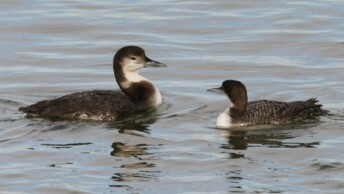Puffins are three closely related seabird species in the genus Fratercula of the auk family (Alcidae), instantly recognizable by their colorful bills and contrasting plumage. All three occur in North America, breeding from the rocky islands of Maine to the remote cliffs of Alaska. Although they spend most of the year at sea, they return each summer to nest in colonies, where their vivid appearance and animated behavior make them some of the most remarkable seabirds of the northern oceans.
Atlantic Puffin
Fratercula arctica
- Identification: Medium-sized seabird with black upperparts, white underparts, pale face, large triangular multi-colored bill, and bright orange legs.
- Where found: Breeds on rocky islands and coastal cliffs across the North Atlantic, from Maine and eastern Canada to Iceland, Norway, and Russia; winters far offshore in open ocean.
- How to spot: Look for its football-shaped body, rapid whirring flight, and bright bill and legs in summer; often seen rafting in groups near colonies.
- Conservation status: Vulnerable globally; in North America populations stable overall, though threatened locally by food shortages, introduced predators, and past exploitation.
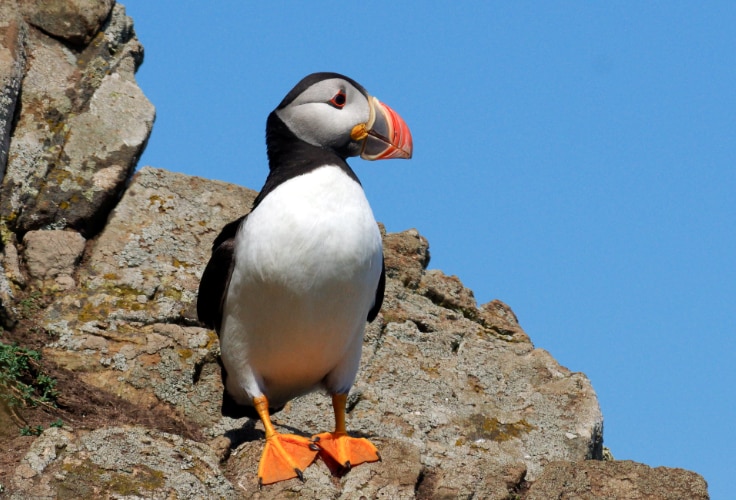
The Atlantic puffin is the most widespread and familiar puffin in North America, and the only one found on the Atlantic coast. Adults measure 26 to 29 centimeters (10.2 to 11.4 inches) in length and appear stocky with a large head and short wings. Their colorful summer bill and clown-like face pattern make them one of the most iconic seabirds of the North Atlantic.
In breeding plumage, adults show black upperparts and a white breast and belly, with a pale grayish face set off by a dark line through the eye. The bill is deep and laterally compressed, orange-red with gray and yellow tones, and the legs are bright orange. After breeding, the bill plates are shed and the face darkens, giving a duller look at sea. Males and females are similar, though males average slightly larger with deeper bills. Juveniles resemble adults but have smaller, darker bills and duller legs.

In the field, puffins are distinctive when seen well. They waddle with a rolling gait on land and often gather in noisy, social groups near burrow entrances. In flight they beat their short wings rapidly, giving a fast, buzzing quality, and at sea they dive and “fly” underwater with their wings, steering with their feet. They usually forage in small groups, carrying several fish crosswise in the bill thanks to special spines on the tongue and palate. Calls are rarely heard away from colonies, but the moaning, growling, and pig-like grunts are characteristic within burrows and social displays. Their diet in North America is dominated by schooling fish such as sand lance, herring, capelin, and hake.
Breeding colonies occur from Maine north through the Canadian Maritimes, Quebec, Labrador, Newfoundland, and into Nunavut, with major sites on islands such as Machias Seal Island, Witless Bay, Baccalieu Island, and Great Bird Rock. They nest in burrows dug into grassy slopes or in crevices among rocks, often returning to the same site year after year. Outside the breeding season, puffins spend months at sea, ranging widely across the North Atlantic but generally remaining offshore and rarely seen from land. Winter records extend from southern Greenland and Labrador south to offshore waters of Massachusetts, with rare strays farther south.
Populations in North America are considered stable today, thanks in part to conservation measures. Puffins were extirpated from the United States by hunting in the 1800s, but restoration efforts led by Project Puffin have reestablished colonies in Maine. Globally, however, the species is in decline, especially in Europe, where warming seas have reduced key prey like sandlance and caused repeated breeding failures. Other threats include introduced predators at nesting colonies, entanglement in fishing gear, and pollution. Continued protection of colonies and healthy marine ecosystems remains essential for the long-term future of this emblematic seabird.
Horned Puffin
Fratercula corniculata
- Identification: Medium-sized, black-and-white seabird with a very thick yellow-and-red, triangular bill, white face, and bright orange legs and feet.
- Where found: Breeds mainly in Alaska (Aleutians, Gulf of Alaska, Bering and Chukchi Seas) with small numbers in British Columbia; winters far offshore across the central North Pacific.
- How to spot: Look for the bold white underparts (unlike the all-dark tufted puffin), football-like body, rapid direct flight, and, at close range in summer, the small dark “horn” above the eye.
- Conservation status: Least Concern globally; considered of low conservation concern in North America, but vulnerable to prey shifts from warming seas, past gill-net bycatch, and marine debris.

The horned puffin is the characteristic puffin of the North Pacific and a familiar breeder across Alaska’s vast island chains. Adults measure 36 to 41 centimeters (14.2 to 16.1 inches) in length and look stocky with a short neck and very deep, laterally compressed bill. In North America it is widespread around Alaska, where immense colonies on offshore islands make it a signature seabird of summer.
Breeding adults are black above with a striking white face and clean white underparts, creating a bold black “collar” effect across the chin and throat. The oversized bill is bright yellow with a red tip and shows vertical grooves; an orange rictal rosette sits at the gape. Legs and feet are vivid orange. At close range, a small dark, leathery spike above the eye forms the namesake “horn.” After breeding, the face darkens to gray, the horn and bill ornaments are shed, and the bill looks smaller and duller. Sexes appear alike except that males average slightly larger; juveniles are similar to non-breeding adults but with a smaller, brownish bill lacking grooves.
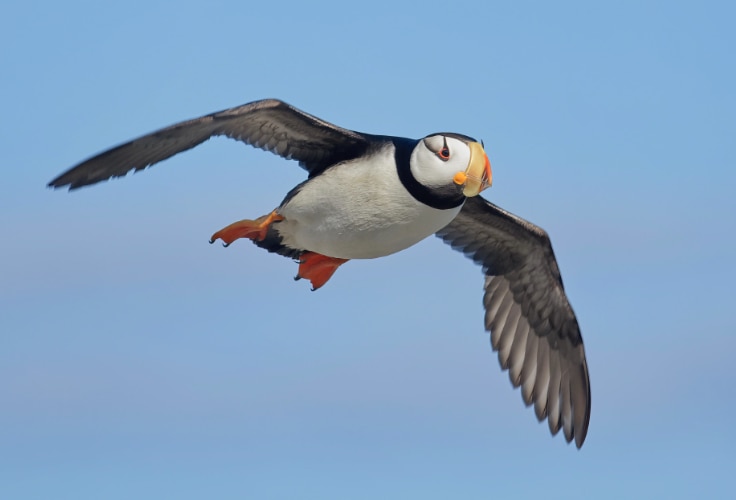
In the field, horned puffins fly fast and direct, typically 10 to 30 meters (30 to 100 feet) above the sea, with rapid wingbeats and limited maneuverability. They waddle upright across rocks and launch from ledges or by running over the water. Like other alcids, they are powerful wing-propelled divers, capturing small schooling fishes underwater and often carrying multiple fish crosswise in the bill. At colonies and at sea they can be quite social, gathering in small rafts or making repeated circular “fly-bys” over the cliffs. Vocalizations at colonies are low growls and purrs; away from colonies they are generally quiet.
In North America the core breeding range is Alaska – Aleutians, Gulf of Alaska, Bering Sea, and Chukchi Sea, with colonies on islands such as the Semidi and Shumagin groups, the Pribilofs, St. Matthew and St. Lawrence Islands, and Cape Lisburne. They also breed in very small numbers in British Columbia (for example, Anthony Island). Nesting is chiefly in rock crevices among boulders and talus or in cliff cracks; some colonies use earthen burrows on grassy slopes. Outside the breeding season, horned puffins disperse widely over the central North Pacific, generally far offshore and rarely visible from the mainland coasts.
Regionally, the species remains relatively common, but recent warm-water events in the North Pacific have reduced prey availability and caused periodic die-offs in Alaska. Historical gill-net bycatch killed many birds at sea, though changes in fisheries have lessened that threat; ingestion of plastic and broader climate-driven shifts in forage fish remain concerns. Continued protection of nesting islands and prudent fisheries and marine debris management are important to keep North American populations secure.
Tufted Puffin
Fratercula cirrhata
- Identification: Large puffin with all-dark body, white face, long golden head plumes, thick orange bill, and bright orange legs.
- Where found: Breeds on offshore islands and cliffs from California north through British Columbia and Alaska into the Bering and Chukchi Seas, and across northeast Asia; winters widely across the central North Pacific.
- How to spot: Look for the striking golden tufts sweeping back from the head and the dark body contrasting with the white face; flies with rapid wingbeats and often seen rafting in small groups near colonies.
- Conservation status: Least Concern globally; populations stable overall but locally reduced by introduced predators, fisheries bycatch, plastic ingestion, and warming seas altering prey.
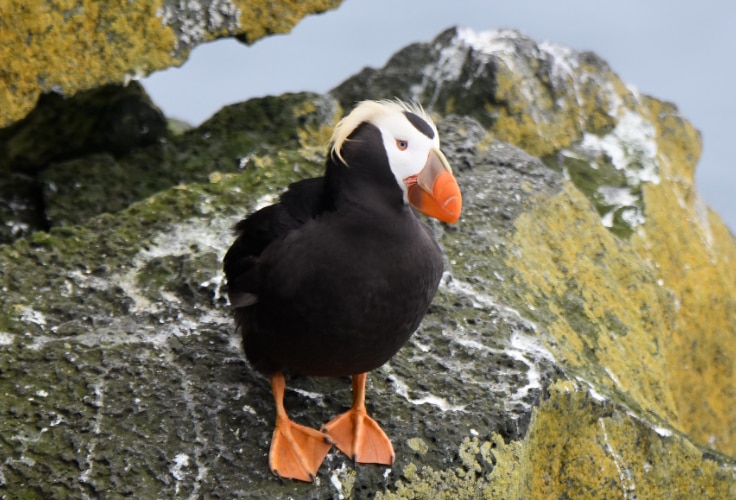
The tufted puffin is the largest puffin and the most distinctive seabird of the North Pacific. Adults measure 36 to 42 centimeters (14.2 to 16.5 inches) in length and have a heavy, triangular bill and a robust body. In North America it is widespread along the Pacific coast, breeding farther south than the horned puffin and occupying islands from California north to the Arctic seas of Alaska.
In breeding plumage, adults are blackish overall with a clean white facial mask and long golden plumes that trail from the crown and nape. The massive bill is bright orange with yellow and red tones, highlighted by a small fleshy rosette at the base. Legs and feet are orange to reddish. Non-breeding adults lose the plumes, the face darkens, and the bill plates are shed, leaving a smaller, duller orange bill. Juveniles resemble non-breeding birds with a shorter, narrower, brownish bill. Males and females look alike, though males average slightly larger.
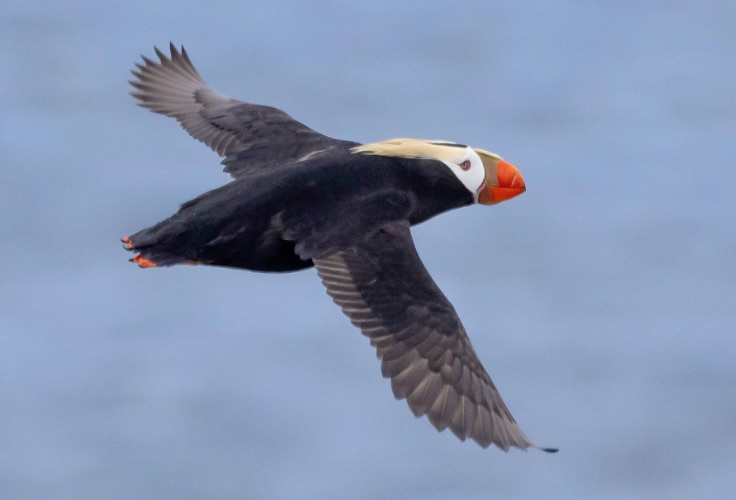
Tufted puffins are unmistakable when close, with their flashy plumes and oversized bill. In flight they beat their short wings rapidly, often circling over colonies or flying in loose groups of two to twenty individuals. They are powerful divers, propelling themselves underwater with half-open wings and capturing schooling fishes, squid, and invertebrates. Adults carry multiple fish crosswise in the bill when provisioning chicks. At colonies they engage in elaborate courtship, rubbing bills, head-jerking, bowing, and wing-raising displays. Their calls are low growls and purrs, but they are generally silent away from breeding grounds.
Breeding colonies span a vast Pacific arc, from small reestablished sites in California’s Channel and Farallon Islands to major colonies in Oregon, Washington, British Columbia, and Alaska. Immense concentrations occur in the Aleutians, Gulf of Alaska, and Bering Sea islands, with the northern limit at Cape Lisburne in the Chukchi Sea. Nests are usually placed in burrows dug into grassy slopes, though crevices in talus and cliff cracks are also used. Outside the breeding season, tufted puffins disperse widely across the central North Pacific, becoming scarce near coasts and favoring pelagic waters south to about 35°N.
The species remains common and widely distributed, but pressures are mounting. Historical bycatch in drift-net fisheries killed many thousands annually, though regulations have reduced mortality. On some islands, introduced predators such as rats and foxes eliminated nesting puffins. Climate-driven changes in ocean temperature have altered prey availability, contributing to die-offs in recent years. Ingested plastic at sea is another growing concern. Despite these threats, large colonies in Alaska and Russia keep the species secure, though continued conservation of island habitats and marine ecosystems will be crucial for its long-term health.
Puffins and Their Future
Puffins are icons of the northern oceans, their vivid bills and bustling colonies making them favorites among birdwatchers and researchers alike. While they remain widespread across the North Atlantic and North Pacific, changing seas, introduced predators, and other human pressures are reshaping their future. In North America, careful management and restoration projects have helped secure key colonies, reminding us that with protection and attention, even the most vulnerable seabirds can continue to thrive along our coasts.


